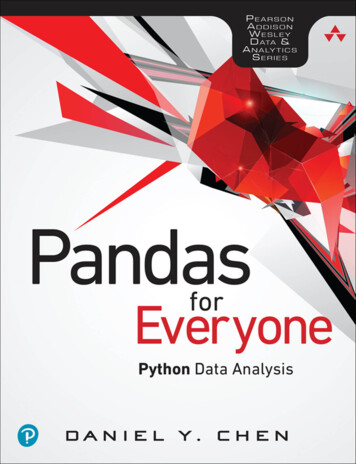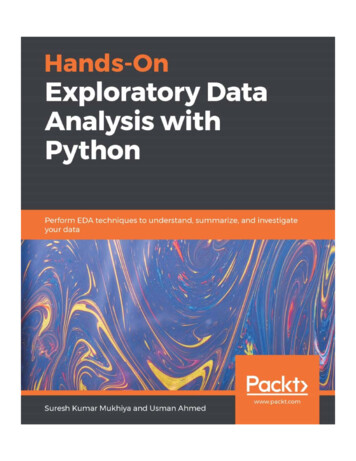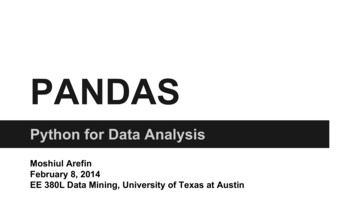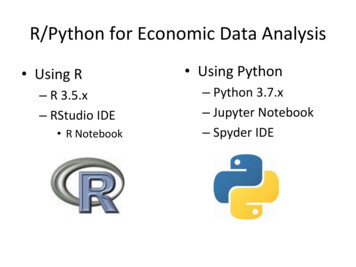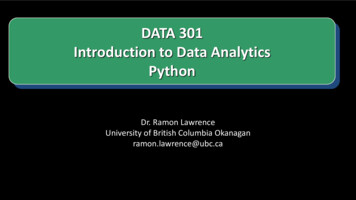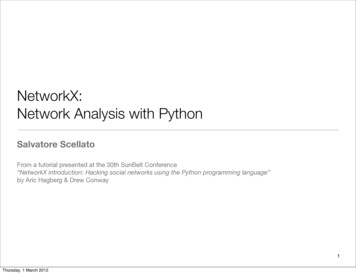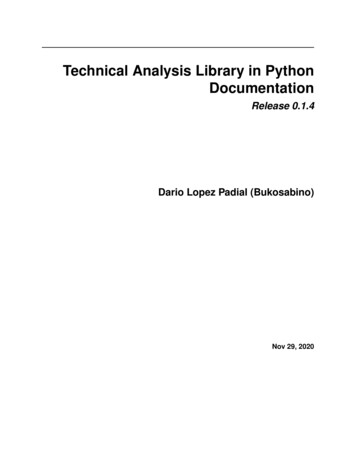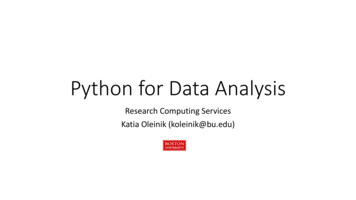
Transcription
Python for Data AnalysisResearch Computing ServicesKatia Oleinik (koleinik@bu.edu)
Tutorial ContentOverview of Python Libraries for DataScientistsReading Data; Selecting and Filtering the Data; Data manipulation,sorting, grouping, rearrangingPlotting the dataDescriptive statisticsInferential statistics2
Python Libraries for Data ScienceMany popular Python toolboxes/libraries: NumPySciPyPandasSciKit-LearnAll these libraries areinstalled on the SCCVisualization libraries matplotlib Seabornand many more 3
Python Libraries for Data ScienceNumPy: introduces objects for multidimensional arrays and matrices, as well asfunctions that allow to easily perform advanced mathematical and statisticaloperations on those objects provides vectorization of mathematical operations on arrays and matriceswhich significantly improves the performance many other python libraries are built on NumPyLink: http://www.numpy.org/4
Python Libraries for Data ScienceSciPy: collection of algorithms for linear algebra, differential equations, numericalintegration, optimization, statistics and more part of SciPy Stack built on NumPyLink: https://www.scipy.org/scipylib/5
Python Libraries for Data SciencePandas: adds data structures and tools designed to work with table-like data (similarto Series and Data Frames in R) provides tools for data manipulation: reshaping, merging, sorting, slicing,aggregation etc. allows handling missing dataLink: http://pandas.pydata.org/6
Python Libraries for Data ScienceSciKit-Learn: provides machine learning algorithms: classification, regression, clustering,model validation etc. built on NumPy, SciPy and matplotlibLink: http://scikit-learn.org/7
Python Libraries for Data Sciencematplotlib: python 2D plotting library which produces publication quality figures in avariety of hardcopy formats a set of functionalities similar to those of MATLAB line plots, scatter plots, barcharts, histograms, pie charts etc. relatively low-level; some effort needed to create advanced visualizationLink: https://matplotlib.org/8
Python Libraries for Data ScienceSeaborn: based on matplotlib provides high level interface for drawing attractive statistical graphics Similar (in style) to the popular ggplot2 library in RLink: https://seaborn.pydata.org/9
Login to the Shared Computing Cluster Use your SCC login information if you have SCC account If you are using tutorial accounts see info on the blackboardNote: Your password will not be displayed while you enter it.10
Selecting Python Version on the SCC# view available python versions on the SCC[scc1 ] module avail python# load python 3 version[scc1 ] module load python/3.6.211
Download tutorial notebook# On the Shared Computing Cluster[scc1 ] cp /project/scv/examples/python/data analysis/dataScience.ipynb .# On a local computer save the link:http://rcs.bu.edu/examples/python/data analysis/dataScience.ipynb12
Start Jupyter nootebook# On the Shared Computing Cluster[scc1 ] jupyter notebook13
Loading Python LibrariesIn [ ]:#Import Python Librariesimport numpy as npimport scipy as spimport pandas as pdimport matplotlib as mplimport seaborn as snsPress Shift Enter to execute the jupyter cell14
Reading data using pandasIn [ ]: #Read csv filedf pd.read csv("http://rcs.bu.edu/examples/python/data analysis/Salaries.csv")Note: The above command has many optional arguments to fine-tune the data import process.There is a number of pandas commands to read other data formats:pd.read excel('myfile.xlsx',sheet name 'Sheet1', index col None, na values ['NA'])pd.read stata('myfile.dta')pd.read sas('myfile.sas7bdat')pd.read hdf('myfile.h5','df')15
Exploring data framesIn [3]: #List first 5 recordsdf.head()Out[3]:16
Hands-on exercises Try to read the first 10, 20, 50 records; Can you guess how to view the last few records;Hint:17
Data Frame data typesPandas TypeNative Python TypeDescriptionobjectstringThe most general dtype. Will beassigned to your column if columnhas mixed types (numbers andstrings).int64intNumeric characters. 64 refers tothe memory allocated to hold thischaracter.float64floatNumeric characters with decimals.If a column contains numbers andNaNs(see below), pandas willdefault to float64, in case yourmissing value has a decimal.datetime64, timedelta[ns]N/A (but see the datetime modulein Python’s standard library)Values meant to hold time data.Look into these for time seriesexperiments.18
Data Frame data typesIn [4]: #Check a particular column typedf['salary'].dtypeOut[4]: dtype('int64')In [5]: #Check types for all the columnsdf.dtypesOut[4]: rankdisciplinephdservicesexsalarydtype: objectobjectobjectint64int64objectint6419
Data Frames attributesPython objects have attributes and methods.df.attributedescriptiondtypeslist the types of the columnscolumnslist the column namesaxeslist the row labels and column namesndimnumber of dimensionssizenumber of elementsshapereturn a tuple representing the dimensionalityvaluesnumpy representation of the data20
Hands-on exercises Find how many records this data frame has; How many elements are there? What are the column names? What types of columns we have in this data frame?21
Data Frames methodsUnlike attributes, python methods have parenthesis.All attributes and methods can be listed with a dir() function: dir(df)df.method()descriptionhead( [n] ), tail( [n] )first/last n rowsdescribe()generate descriptive statistics (for numeric columns only)max(), min()return max/min values for all numeric columnsmean(), median()return mean/median values for all numeric columnsstd()standard deviationsample([n])returns a random sample of the data framedropna()drop all the records with missing values22
Hands-on exercises Give the summary for the numeric columns in the dataset Calculate standard deviation for all numeric columns; What are the mean values of the first 50 records in the dataset? Hint: usehead() method to subset the first 50 records and then calculate the mean23
Selecting a column in a Data FrameMethod 1: Subset the data frame using column name:df['sex']Method 2: Use the column name as an attribute:df.sexNote: there is an attribute rank for pandas data frames, so to select a column with a name"rank" we should use method 1.24
Hands-on exercises Calculate the basic statistics for the salary column; Find how many values in the salary column (use count method); Calculate the average salary;25
Data Frames groupby methodUsing "group by" method we can: Split the data into groups based on some criteria Calculate statistics (or apply a function) to each group Similar to dplyr() function in RIn [ ]: #Group data using rankdf rank df.groupby(['rank'])In [ ]: #Calculate mean value for each numeric column per each groupdf rank.mean()26
Data Frames groupby methodOnce groupby object is create we can calculate various statistics for each group:In [ ]: #Calculate mean salary for each professor rank:df.groupby('rank')[['salary']].mean()Note: If single brackets are used to specify the column (e.g. salary), then the output is Pandas Series object.When double brackets are used the output is a Data Frame27
Data Frames groupby methodgroupby performance notes:- no grouping/splitting occurs until it's needed. Creating the groupby objectonly verifies that you have passed a valid mapping- by default the group keys are sorted during the groupby operation. You maywant to pass sort False for potential speedup:In [ ]: #Calculate mean salary for each professor rank:df.groupby(['rank'], sort False)[['salary']].mean()28
Data Frame: filteringTo subset the data we can apply Boolean indexing. This indexing is commonlyknown as a filter. For example if we want to subset the rows in which the salaryvalue is greater than 120K:In [ ]: #Calculate mean salary for each professor rank:df sub df[ df['salary'] 120000 ]Any Boolean operator can be used to subset the data: greater; greater or equal; less; less or equal; equal;! not equal;In [ ]: #Select only those rows that contain female professors:df f df[ df['sex'] 'Female' ]29
Data Frames: SlicingThere are a number of ways to subset the Data Frame: one or more columns one or more rows a subset of rows and columnsRows and columns can be selected by their position or label30
Data Frames: SlicingWhen selecting one column, it is possible to use single set of brackets, but theresulting object will be a Series (not a DataFrame):In [ ]: #Select column salary:df['salary']When we need to select more than one column and/or make the output to be aDataFrame, we should use double brackets:In [ ]: #Select column salary:df[['rank','salary']]31
Data Frames: Selecting rowsIf we need to select a range of rows, we can specify the range using ":"In [ ]: #Select rows by their position:df[10:20]Notice that the first row has a position 0, and the last value in the range is omitted:So for 0:10 range the first 10 rows are returned with the positions starting with 0and ending with 932
Data Frames: method locIf we need to select a range of rows, using their labels we can use method loc:In [ ]: #Select rows by their labels:df sub.loc[10:20,['rank','sex','salary']]Out[ ]:33
Data Frames: method ilocIf we need to select a range of rows and/or columns, using their positions we canuse method iloc:In [ ]: #Select rows by their labels:df sub.iloc[10:20,[0, 3, 4, 5]]Out[ ]:34
Data Frames: method iloc (summary)df.iloc[0] # First row of a data framedf.iloc[i] #(i 1)th rowdf.iloc[-1] # Last rowdf.iloc[:, 0] # First columndf.iloc[:, -1] # Last columndf.iloc[0:7]#First 7 rowsdf.iloc[:, 0:2]#First 2 columnsdf.iloc[1:3, 0:2] #Second through third rows and first 2 columnsdf.iloc[[0,5], [1,3]] #1st and 6th rows and 2nd and 4th columns35
Data Frames: SortingWe can sort the data by a value in the column. By default the sorting will occur inascending order and a new data frame is return.In [ ]: # Create a new data frame from the original sorted by the column Salarydf sorted df.sort values( by 'service')df sorted.head()Out[ ]:36
Data Frames: SortingWe can sort the data using 2 or more columns:In [ ]: df sorted df.sort values( by ['service', 'salary'], ascending [True, False])df sorted.head(10)Out[ ]:37
Missing ValuesMissing values are marked as NaNIn [ ]: # Read a dataset with missing valuesflights pd.read csv("http://rcs.bu.edu/examples/python/data analysis/flights.csv")In [ ]: # Select the rows that have at least one missing valueflights[flights.isnull().any(axis 1)].head()Out[ ]:38
Missing ValuesThere are a number of methods to deal with missing values in the data frame:df.method()descriptiondropna()Drop missing observationsdropna(how 'all')Drop observations where all cells is NAdropna(axis 1, how 'all')Drop column if all the values are missingdropna(thresh 5)Drop rows that contain less than 5 non-missing valuesfillna(0)Replace missing values with zerosisnull()returns True if the value is missingnotnull()Returns True for non-missing values39
Missing Values When summing the data, missing values will be treated as zero If all values are missing, the sum will be equal to NaN cumsum() and cumprod() methods ignore missing values but preserve them inthe resulting arrays Missing values in GroupBy method are excluded (just like in R) Many descriptive statistics methods have skipna option to control if missingdata should be excluded . This value is set to True by default (unlike R)40
Aggregation Functions in PandasAggregation - computing a summary statistic about each group, i.e. compute group sums or means compute group sizes/countsCommon aggregation functions:min, maxcount, sum, prodmean, median, mode, madstd, var41
Aggregation Functions in Pandasagg() method are useful when multiple statistics are computed per column:In [ ]: flights[['dep delay','arr delay']].agg(['min','mean','max'])Out[ ]:42
Basic Descriptive Statisticsdf.method()descriptiondescribeBasic statistics (count, mean, std, min, quantiles, max)min, maxMinimum and maximum valuesmean, median, modeArithmetic average, median and modevar, stdVariance and standard deviationsemStandard error of meanskewSample skewnesskurtkurtosis43
Graphics to explore the dataSeaborn package is built on matplotlib but provides high levelinterface for drawing attractive statistical graphics, similar to ggplot2library in R. It specifically targets statistical data visualizationTo show graphs within Python notebook include inline directive:In [ ]: %matplotlib inline44
e of central tendency for a numeric variableviolinplotsimilar to boxplot, also shows the probability density of thedatajointplotScatterplotregplotRegression ical scatterplotfactorplotGeneral categorical plot45
Basic statistical Analysisstatsmodel and scikit-learn - both have a number of function for statistical analysisThe first one is mostly used for regular analysis using R style formulas, while scikit-learn ismore tailored for Machine Learning.statsmodels: linear regressions ANOVA tests hypothesis testings many more .scikit-learn: kmeans support vector machines random forests many more .See examples in the Tutorial Notebook46
ConclusionThank you for attending the tutorial.Please fill the evaluation form:http://scv.bu.edu/survey/tutorial evaluation.htmlQuestions:email: koleinik@bu.edu (Katia Oleinik)47
Python Libraries for Data Science NumPy: introduces objects for multidimensional arrays and matrices, as well as functions that allo



